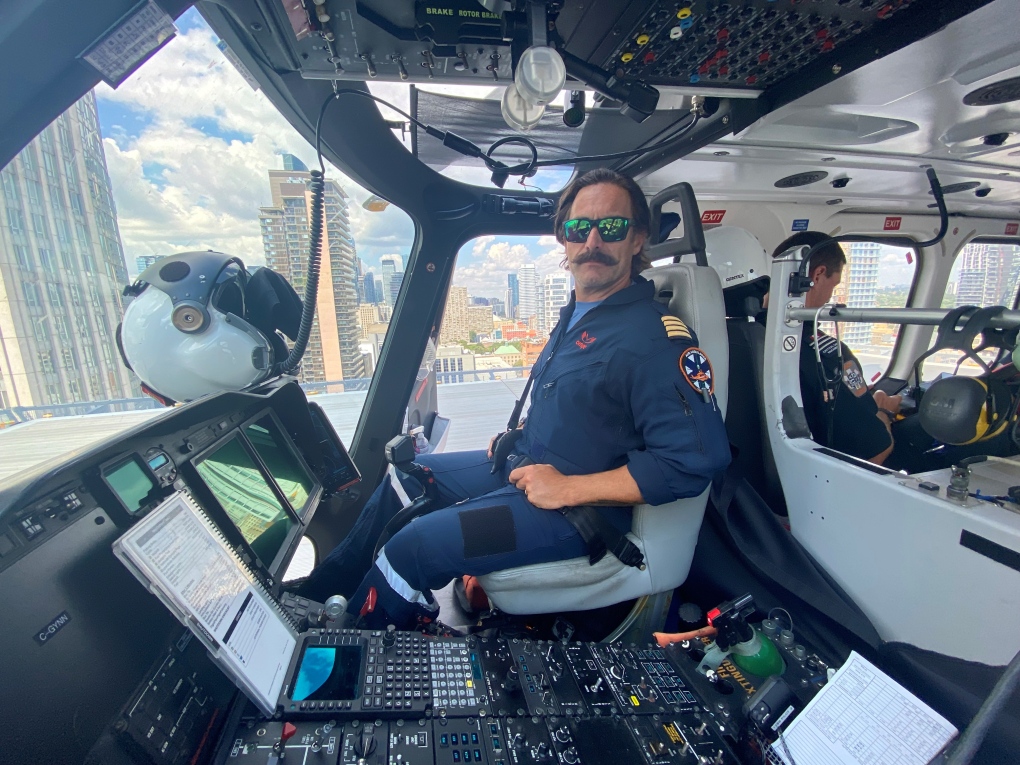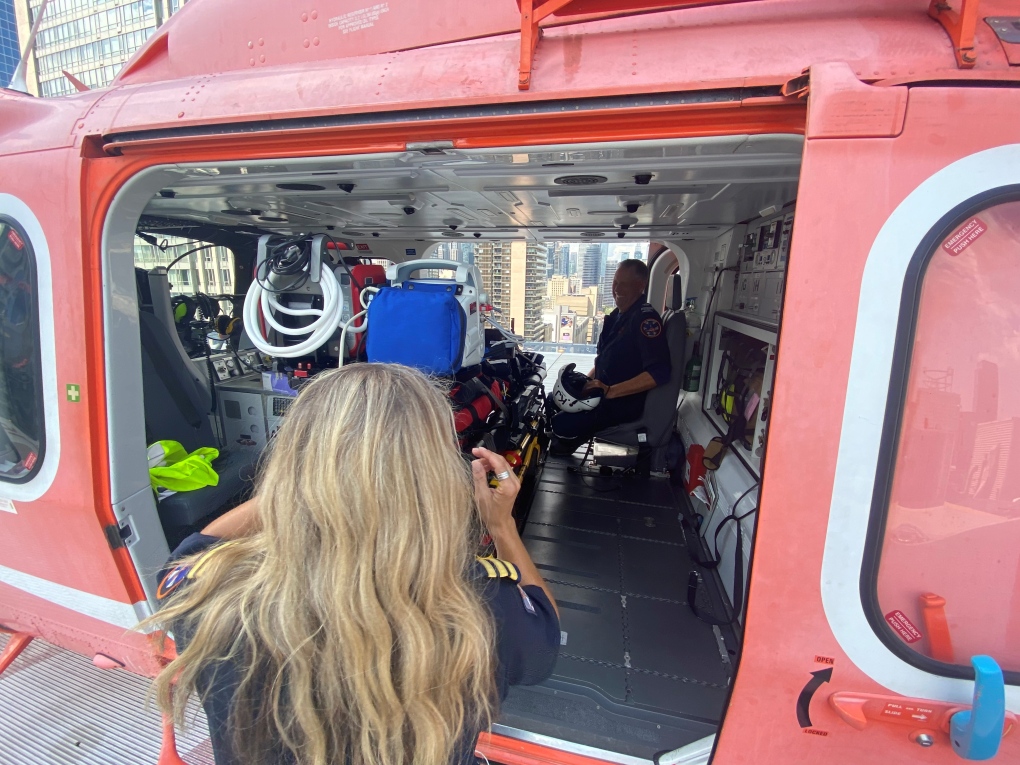'Multiple trauma calls a day': A day in the life of an Ornge air ambulance crew
Like chains holding our healthcare system together, Ornge Air Ambulances are tasked with covering over a million square kilometres of Ontario landscape, and CTV News Toronto recently went along for the ride on one of their calls.
"What we do is unique," says Capt. Jaret Blowers, a pilot with Ornge since 2005. He adds, "It can be tough, it can be enjoyable. And what it does is, it potentially makes real differences in peoples lives."
Blowers is the pilot and alongside him is first officer Jenny Balon. They work inside the cockpit.
Balon says this job, "is a joy, you never know what the day is going to bring."
In the back are Kevin Joness, with over 30 years of experience, and Curtis McIntyre who just recently became a critical care paramedic.
Critical care paramedics require a special level of expertise. Working with Ornge means they need to be able to care for some of the worst cases, in some of the most remote locations.
 On-board the Ornge air ambulance. (CTV News Toronto/Sean Leathong)
On-board the Ornge air ambulance. (CTV News Toronto/Sean Leathong)
McIntyre, says it is "a larger scope of practice that you kind of have worked up to throughout your whole career."
Crews here work 12 hour shifts. Starting at 7am, this crew is briefed before walking through some safety checks. Stationed out of the Toronto Island airport, this is just one of 12 bases Ornge can fly from.
The summer has been busy, so McIntyre says they come expecting to be active.
"We're out on multiple trauma calls a day," he says. He talked about the wide variety of calls they receive, saying, "I've been on deliveries, very sick ICU patients have been brought into toronto to one of the bigger hospitals."
When a call comes in, the crew take only minutes to gather what is needed and get in the air.
Inside the cabin is tight and loud. Helmets and hearing protection are mandatory as the sound of the propellers is defining. Speaking through the radio, McIntyre shares where they are headed.
"We're going to Parry Sound on a call. To us bring a patient back down to Toronto," he says.
In just 45 minutes the helicopter lands, and Joness and McIntyre head inside for the patient transfer.
The patient is a woman who is having complications after receiving a kidney transplant. The hospital in Parry Sound cannot provide what she needs, therefore she will be moved to St. Michael’s Hospital in Toronto.
After the patient is in the care of Ornge, it takes less than 5 minutes before she is secured into the helicopter and in the air.
 Inside an Ornge air ambulance helicopter. (CTV News Toronto/Sean Leathong)
Each Ornge Air Ambulance is like a miniature hospital, as they have much more medication than a conventional ambulance. There is even a ventilator.
Inside an Ornge air ambulance helicopter. (CTV News Toronto/Sean Leathong)
Each Ornge Air Ambulance is like a miniature hospital, as they have much more medication than a conventional ambulance. There is even a ventilator.
This call requires the crew to land on the roof of St. Michael’s Hospital in the heart of downtown Toronto. The helicopter comes in from the northeast, resting on the helicopter-pad, and inless than an hour the patient is moved to where she can get the best care.
Each call for Ornge could be an emergency. When there is a patient in need of life saving measures their jobs are simple. The paramedics goal is to stabilize, and the pilots goal is to move as quickly as possible.
They know what the risks of this job can be and they also know they can help.
"I can think of quite a few of those, where I positively know, the job we did saved someone's life," says Blowers.
Balon says "when you're there at the right time, it's a great feeling. It's a really great feeling, to be there."
Lifting off from St. Michael's, the aircraft weaves through the skyscrapers on the way back to base. Through the cabin radio, Joness says the view never gets old.
"It's great to see the city and how much it's progressed over the years," he says. He adds, "every time I go up, I always see a new condo. And it's always great at night when it's all lit up, very picturesque."
Just a moment to look, because they never know when the next call will come.
CTVNews.ca Top Stories

BREAKING Israel attacks Iran, Reuters sources say; drones reported over Isfahan
Israel has attacked Iran, three people familiar with the matter told Reuters, as Iranian state media reported early on Friday that its forces had destroyed drones, days after Iran launched a retaliatory drone strike on Israel.
American millionaire Jonathan Lehrer denied bail after being charged with killing Canadian couple
American millionaire Jonathan Lehrer, one of two men charged in the killings of a Canadian couple in Dominica, has been denied bail.
Nearly half of China's major cities are sinking, researchers say
Nearly half of China's major cities are suffering 'moderate to severe' levels of subsidence, putting millions at risk of flooding especially as sea levels rise.
Prince Harry formally confirms he is now a U.S. resident
Prince Harry, the son of King Charles III and fifth in line to the British throne, has formally confirmed he is now a U.S. resident.
Judge says 'no evidence fully supports' murder case against Umar Zameer as jury starts deliberations
The judge presiding over the trial of a man accused of fatally running over a Toronto police officer is telling jurors the possible verdicts they may reach based on the evidence in the case.
Health Canada to change sperm donor screening rules for men who have sex with men
Health Canada will change its longstanding policy restricting gay and bisexual men from donating to sperm banks in Canada, CTV News has learned. The federal health agency has adopted a revised directive removing the ban on gay, bisexual and other men who have sex with men, effective May 8.
Colin Jost names one celebrity who is great at hosting 'Saturday Night Live'
Colin Jost, who co-anchors Saturday Night Live's 'Weekend Update,' revealed who he thinks is one of the best hosts on the show.
Sports columnist apologizes for 'oafish' comments directed at Caitlin Clark. The controversy isn't over
A male columnist has apologized for a cringeworthy moment during former University of Iowa superstar and college basketball's highest scorer Caitlin Clark's first news conference as an Indiana Fever player.
'Shopaholic' author Sophie Kinsella reveals brain cancer diagnosis
Sophie Kinsella, the best-selling author behind the 'Shopaholic' book series, has revealed that she is receiving treatment for brain cancer.
































